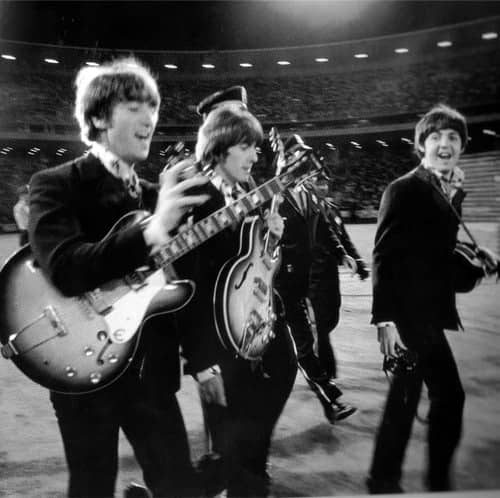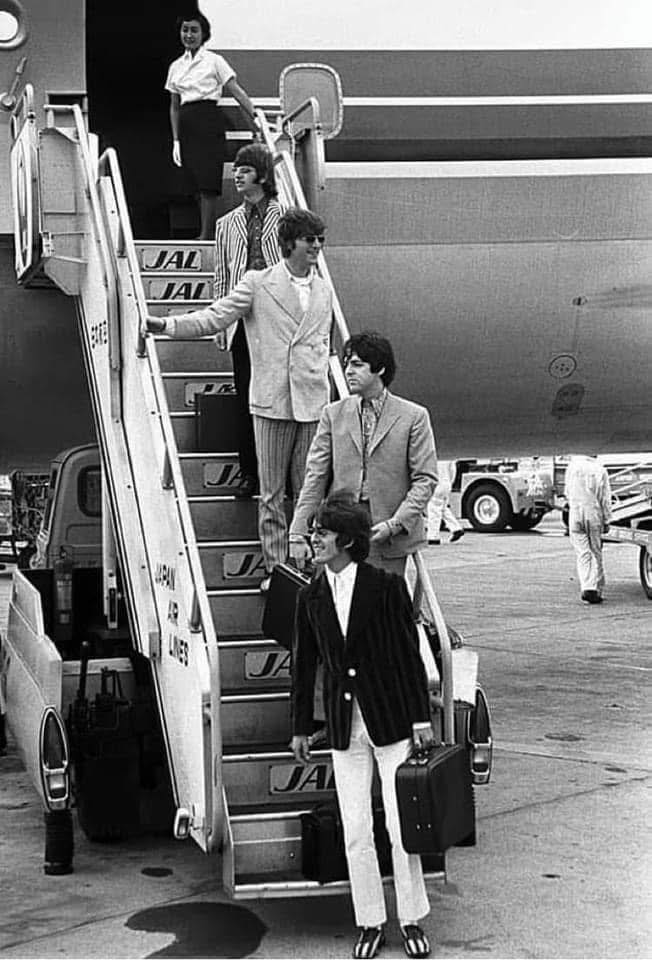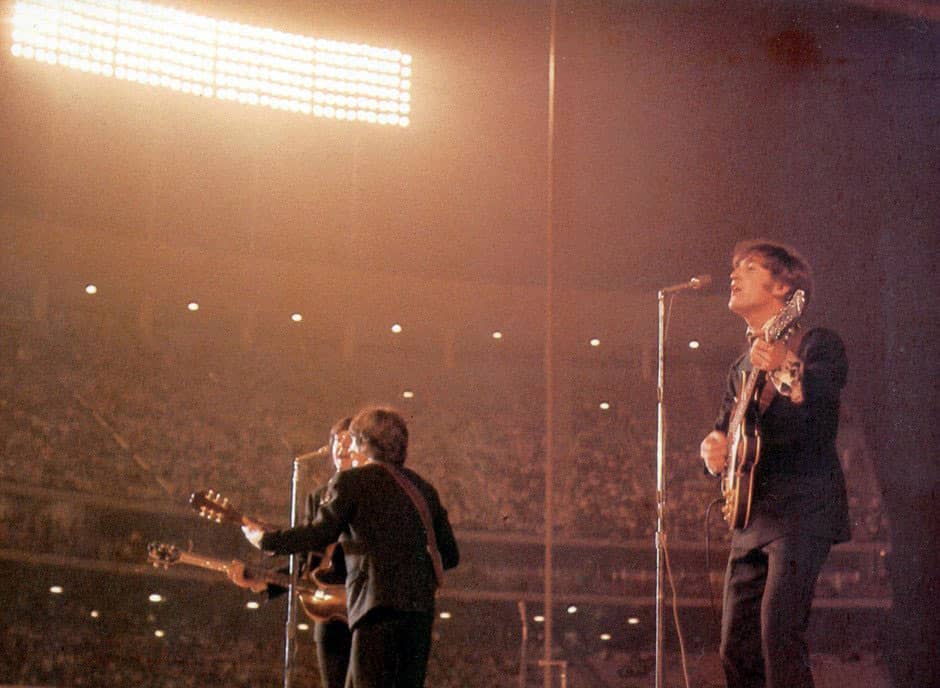The Toppermost of the Poppermost

When The Beatles were playing early shows in Liverpool and Hamburg, questioning whether it was all worth it, John Lennon would say the following lines: ‘Where are we going, fellows?'” The band would reply,”‘To the top, Johnny’, in pseudo-American voices.” Lennon elucidated, “And I would say, ‘Where is that, fellows?’ And they would say, ‘To the toppermost of the poppermost.’ I would say, ‘Right!’ And we would all cheer up.”
By 1966 though, The Beatles had reached the toppermost of the poppermost, and were asking themselves an entirely different question.
Was touring worth it?
Build Up
By 1966, The Beatles were comfortably the biggest band in the world. As they prepared to tour America that summer, controversy loomed over comments John Lennon had made months earlier: “We’re more popular than Jesus now; I don’t know which will go first, rock ’n’ roll or Christianity.” The remark sparked outrage among U.S. religious and social conservatives, and even drew threats from the Ku Klux Klan. Yet, despite the backlash, every show on the upcoming tour would still sell out.
Just a week before the tour began, the band released ‘Revolver’, an album that marked a bold step forward in their artistry. It showcased ambitious studio experimentation, sophisticated songwriting, and a wider range of musical styles, the band were moving away from writing songs for live performance.
Preparations for the tour were troubled from the start. The band already sensed it wasn’t going to work. Stadium concerts of that scale were unprecedented. The Beatles had moved on from theatres to sports arenas, but sound technology hadn’t kept up. Their specially designed 100-watt Vox amplifiers, powerful by mid-’60s standards, were still no match for the deafening screams of Beatlemania. Performing live had become almost impossible.
The chaos surrounding the band wasn’t confined to America. During their world tour earlier that year, The Beatles were met with overwhelming crowds everywhere they went. Things turned dangerous in the Philippines, where a misunderstanding nearly turned disastrous. After unintentionally snubbing First Lady Imelda Marcos, who had expected them to attend a breakfast reception at the Presidential Palace, local outrage escalated into riots. The band narrowly escaped the country with their lives.

In the aftermath, The Beatles retreated to India for the first time, a pivotal moment both personally and creatively. It was there that they told their manager, Brian Epstein, that the upcoming American tour would be their last. They cited two main reasons: their frustration with the inadequate live sound systems and their weariness from the endless stream of trivial questions at press conferences.
The Tour
The Beatles’ 1966 North American tour, their third and final, marked the end of their life on the road. After 19 shows (17 in the U.S. and 2 in Canada), they would never tour again. Apart from their famous rooftop concert at Apple Corps in 1969, The Beatles’ era of live performance was over.
From the outset, the tour was mired in controversy. Lennon’s “more popular than Jesus” remark had resurfaced, reprinted prominently in the U.S. teen magazine Datebook in July 1966. The American reprint placed the quote “I don’t know which will go first, rock ’n’ roll or Christianity!” on its cover, igniting outrage among Christian fundamentalists. Radio stations banned Beatles records, and some organized public bonfires for fans to burn their albums and merchandise.
Brian Epstein flew to New York in an attempt to calm the uproar, but tensions only escalated. Lennon was vilified in the press, and Paul McCartney didn’t help matters when he commented in a radio interview that Americans were “obsessed with money.” Meanwhile, the withdrawn “butcher cover” of ‘Yesterday and Today’ featuring the band in butcher coats surrounded by raw meat and doll parts was interpreted by some as a protest against the Vietnam War, adding another layer of controversy.

Despite the chaos, The Beatles went ahead with the tour. Ticket sales dipped slightly, but the shows still drew massive crowds, probably the biggest concert crowds of the time. The band, however, were increasingly miserable. Death threats, protests, and poor sound plagued every stop. They could barely hear themselves play, and their enthusiasm for live performance had vanished.
By the time the final show concluded, The Beatles were done. The 1966 tour didn’t just mark the end of an era.
The shows themselves followed the typical package tour format of the era. With support acts, the Ronettes, the Cyrkle, Bobby Hebb and the Remains taking to the stage before The Beatles.
The band played a 30 minute set, and did not include any of the songs from 'Revolver' due to the difficulty in reproducing their sophisticated studio sounds and arrangements in a concert setting. 'Paperback Writer' was included in the set, making it the only recording from 1966 to be included in the live setlist.
On the tour The Beatles experienced some crowd trouble, the first serious incident occuring at Cleveland's Municipal Stadium, where the band played to a 30,000 strong crowd. As the band went into 'Day Tripper' over 2,000 fans broke through the security barriers separating the audience from the area housing the elevated stage, the Beatles retreated and sheltered backstage, after around thirty minutes the security was restored and The Beatles finished the set.
Following their concert at Dodger Stadium in Los Angeles on 28 August, the Beatles were unable to leave the venue for about two hours. Around 100 private security personnel had been assigned to control the crowd of 45,000 fans, 7,000 of whom broke through the fencing and thwarted the band's exit in an armoured van.
The Beatles remained trapped in a dressing room until, after two unsuccessful attempts to fool the crowd using decoy vehicles, they were able to escape with assistance from the local police.

The tour's only stopover in the Bible Belt was Memphis, Tennessee, here two shows were scheduled at the Mid-South Coliseum for 19 August. The city council there voted to cancel the afternoon and evening concerts rather than have "municipal facilities be used as a forum to ridicule anyone's religion". The Ku Klux Klan nailed a Beatles LP to a wooden cross, vowing "vengeance", and conservative groups staged further public burnings of Beatles records.
Epstein nevertheless went ahead with the shows, which were preceded by further threats to the group.Members of the Ku Klux Klan demonstrated outside the venue on 19 August, and around 8,000 locals took part in an anti-Beatles rally elsewhere in the city.
The tours final show was at Candlestick Park in San Fransisco to one of the smallest crowds, 25,000. 7000 tickets had been left unsold. A local company called Tempo Productions was in charge of the arrangements. Due to the reduced ticket sales and the expense of paying the Beatles their prearranged $50,000 performance fee, in addition to having to hire an orchestra to satisfy the local musicians union, the concert resulted in a loss for the company. At 9:27 pm, the Beatles took the stage and proceeded to play their eleven-song set.
McCune Sound Services of San Francisco provided the sound system for the concert. The company's log-book entry for the job includes the note: "Bring everything you can find!"
Knowing that this would be their last concert, members of the band took measures of their own to capture their last moments on stage. Each brought a camera and McCartney asked the bands press officer Tony Barrow to make a rough audio tape recording from the field. The recording of this final concert is now widely circulated on bootlegs.

After the show, the Beatles were quickly taken to the airport in an armoured car. They flew from San Francisco to Los Angeles, arriving at 12:50 am. During the flight, Harrison was heard to say: "That's it, then. I'm not a Beatle anymore." The first band member to tire of Beatlemania, Harrison later said of the group's decision to quit touring: "We'd been through every race riot, and every city we went to there was some kind of a jam going on, and police control, and people threatening to do this and that ... and [us] being confined to a little room or a plane or a car. We all had each other to dilute the stress, and the sense of humour was very important ... But there was a point where enough was enough."
Aftermath
The band had released 'Revolver' by the time of the final tour, it proved that The Beatles had two different forms, live and studio. Studio Beatles had become a whole different beast entirely, the last track of 'Revolver' is 'Tomorrow Never Knows' probably the bands most influential song ever.
A song that saw the band trying to recreate the sound in Lennon’s head of monks chanting in some cosmic mountain retreat, to accompany lines cribbed from the Tibetan Book Of The Dead intended to emulate a transcendental acid high, the band experimented with loops, sampling, drone and tape manipulation, creating not just the epitome of psychedelia and exposing pop audiences to anti-materialist Eastern ideas, but effectively inventing dance music.
In contrast, the last song The Beatles played live at Candlestick Park was 'Long Tall Sally' a cover of a song that was 10 years old released by Little Richard. The live outfit and the studio outfit were almost entirely different bands.
Free from the burden of touring, and with a less busy schedule, The Beatles took an increasingly experimental approach in the studio. In November 1966, the band began to record what would become 'Sgt Pepper's Lonely Hearts Club Band'. Dedicating over 700 hours to the recording process. According to engineer Geoff Emerick "everything on Sgt. Pepper had to be different. We had microphones right down in the bells of brass instruments and headphones turned into microphones attached to violins. We used giant primitive oscillators to vary the speed of instruments and vocals and we had tapes chopped to pieces and stuck together upside down and the wrong way around."
These sessions also produced 'Strawberry Fields Forever' and 'Penny Lane'. There was potential that the band were going to write a concept album about their childhoods in Liverpool. If you want to read more about that click here.
'Strawberry Fields Forever' and 'Penny Lane' were released as a double A-side single in Februay 1967, and the album would follow in May 1967. The album recieved musical acclaim, and is now widely regarded as one of the most influential albums of all time

The album became a catalyst for a youthful explosion, the band were seen as the leaders of youth culture. 'Sgt Peppers' led to conversations around so much more than the music, the album was the first major pop/rock LP to include its complete lyrics, which appeared on the back cover. Those lyrics were the subject of critical analysis; for instance, in late 1967 the album was the subject of a scholarly inquiry by American literary critic and professor of English Richard Poirier, who observed that his students were "listening to the group's music with a degree of engagement that he, as a teacher of literature, could only envy".
The elaborate cover also attracted considerable interest and study. A collage designed by pop artists Peter Blake and Jann Haworth, it depicted the group as the fictional band referred to in the album's title track, standing in front of a crowd of famous people.
Sgt. Pepper topped the UK charts for 23 consecutive weeks, with a further four weeks at number 1 in the period through to February 1968. With 2.5 million copies sold within three months of its release, exceeding the success of the previous Beatles albums. It became the first rock album to win the Grammy Award for album of the Year.
The success of ‘Sgt. Pepper’s Lonely Hearts Club Band’ reinforced what many already knew. The Beatles truly excelled in the studio. No longer constrained by the limits of live performance, they embraced recording as an art form in itself. The album’s groundbreaking production, conceptual ambition, and bold experimentation set a new benchmark for popular music, with tracks like ‘Lucy in the Sky with Diamonds’, ‘A Day in the Life’, and ‘With a Little Help from My Friends’ defining a new era of creativity.
From that point on, The Beatles would never look back. Over the next three years, they pushed their artistry to new heights, producing a string of albums that changed the shape of modern music. ‘The White Album’ offered everything from the raw power of ‘Helter Skelter’ to the delicate beauty of ‘Blackbird’ and ‘While My Guitar Gently Weeps’. ‘Abbey Road’ followed with timeless moments like ‘Come Together’, ‘Something’, and the soaring ‘Here Comes the Sun’. Finally, ‘Let It Be’ brought their journey to a close, anchored by songs such as ‘Across the Universe’ and the anthemic title track.
What began as the end of their touring days had, in truth, marked the beginning of their most inspired and enduring chapter one that would leave an indelible mark on the history of popular music.
Thank you for reading
Jack